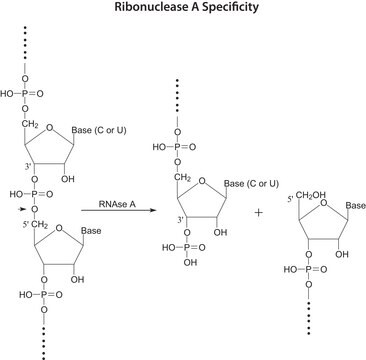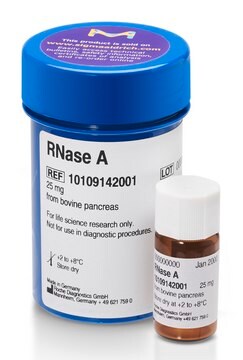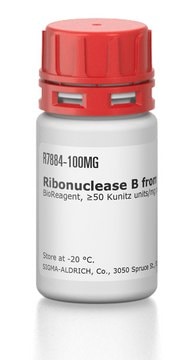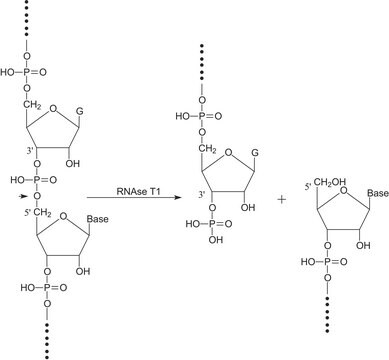R6513
Ribonuclease A from bovine pancreas
for molecular biology, ≥70 Kunitz units/mg protein, lyophilized
Synonym(s):
Pancreatic Ribonuclease, RNAsea, RNase A, Ribonucleate 3′-pyrimidinooligonucleotidohydrolase
About This Item
Recommended Products
grade
for molecular biology
Quality Level
form
lyophilized
specific activity
≥70 Kunitz units/mg protein
mol wt
13.7 kDa
~13,700
foreign activity
Exonuclease and endonuclease, none detected
NICKase and DNase, none detected
storage temp.
−20°C
InChI
1S/C9H14N4O3/c10-2-1-8(14)13-7(9(15)16)3-6-4-11-5-12-6/h4-5,7H,1-3,10H2,(H,11,12)(H,13,14)(H,15,16)
InChI key
CQOVPNPJLQNMDC-UHFFFAOYSA-N
Looking for similar products? Visit Product Comparison Guide
General description
Application
- RNase A is used to remove RNA from DNA plasmid and genomic DNA preparations and protein samples.
- RNase A is also used in RNA sequence analysis and protection assays.
- RNase A has been used as a tool for computer-aided drug design.
- RNase A supports the analysis of RNA sequences.
- RNase A hydrolyze RNA contained in protein samples.
- Purification of DNA is supported by RNase A.
- for plasmid DNA purification
- to digest and avoid staining of double-stranded RNA during staining of nuclei
- in immunoperoxidase and immunofluorescence detection
- to treat cells prior to flow cytometry
- as a component of post-hybridization buffer for washing FFPE tissue sections post in-situ hybridization
- to treat cells during the preparation of outer membrane protein (OMP) extracts
- RNase protection assays
- Removal of unspecifically bound RNA
- Analysis of RNA sequences
- Hydrolysis of RNA contained in protein samples
Features and Benefits
Analysis Note
Other Notes
Boiling stock solutions of this RNase A product to inactivate residual DNase is not necessary and may cause precipitation of RNase and possible loss of enzymatic activity. If an RNase A solution is heated at a neutral pH, precipitation will occur. When heated at a lower pH, some precipitation may occur because of protein impurities that are present.
inhibitor
Signal Word
Danger
Hazard Statements
Precautionary Statements
Hazard Classifications
Resp. Sens. 1
Storage Class Code
11 - Combustible Solids
WGK
WGK 3
Flash Point(F)
Not applicable
Flash Point(C)
Not applicable
Personal Protective Equipment
Regulatory Listings
Regulatory Listings are mainly provided for chemical products. Only limited information can be provided here for non-chemical products. No entry means none of the components are listed. It is the user’s obligation to ensure the safe and legal use of the product.
JAN Code
R6513-250MG:
R6513-1G:
R6513-50MG:
R6513-10MG-PW:
R6513-1G-PW:
R6513-250MG-PW:
R6513-BULK:
R6513PROC:
R6513-BULK-N:
R6513-PH:
R6513-50MG-PW:
R6513-10MG:
R6513-500MG:
R6513-500MG-PW:
R6513-VAR:
Certificates of Analysis (COA)
Search for Certificates of Analysis (COA) by entering the products Lot/Batch Number. Lot and Batch Numbers can be found on a product’s label following the words ‘Lot’ or ‘Batch’.
Already Own This Product?
Find documentation for the products that you have recently purchased in the Document Library.
Customers Also Viewed
Articles
Separation of null
Separation of Ribonuclease A from bovine pancreas, Type I-A, powder, ≥60% RNase A basis (SDS-PAGE), ≥50 Kunitz units/mg protein; α-Chymotrypsinogen A from bovine pancreas, essentially salt-free, lyophilized powder; Cytochrome c from bovine heart, ≥95% based on Mol. Wt. 12,327 basis; Lysozyme from chicken egg white, lyophilized powder, protein ≥90 %, ≥40,000 units/mg protein
Separation of Ribonuclease A from bovine pancreas, Type I-A, powder, ≥60% RNase A basis (SDS-PAGE), ≥50 Kunitz units/mg protein; α-Chymotrypsinogen A from bovine pancreas, essentially salt-free, lyophilized powder; Cytochrome c from bovine heart, ≥95% based on Mol. Wt. 12,327 basis; Lysozyme from chicken egg white, lyophilized powder, protein ≥90 %, ≥40,000 units/mg protein
Protocols
This procedure may be used for determination of Ribonuclease A (RNase A) activity.
Our team of scientists has experience in all areas of research including Life Science, Material Science, Chemical Synthesis, Chromatography, Analytical and many others.
Contact Technical Service







